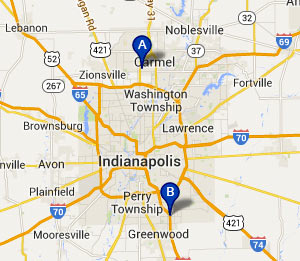Eyelid Closure Weakness
Facial Paralysis (7th Nerve Injury, Bell's Palsy) or Eyelid Scarring
Facial Nerve Injury
The Facial Nerve or the Seventh (7th) Cranial Nerve is responsible for facial and eyelid muscle contraction and movement. If this nerve is injured or dysfunctional, then a facial droop and incomplete eyelid closure may result. This condition is called “Facial Nerve Palsy” or “Seventh Nerve Palsy”. If the cause is not known then it is called a “Bell’s Palsy”. Bells’s palsy frequently improves over several months, but other causes (trauma, skin cancer resection, forehead surgery) of facial nerve palsy may be permanent.
Eyelid Scarring
Scarring in or around the eyelids may result in diminished eyelid excursion and incomplete eyelid closure. Trauma of the eyelids, cheek, eyebrow, or adjacent areas can be a cause of poor eyelid closure. Eyelid surgery also results in scarring of the eyelid skin as well as internal fibrosis (scarring). If this scarring or internal fibrosis is greater than what typically occurs, then eyelid movement may be limited. Excessive scarring may occur due to inflammation from topical medications such as allergy from antibiotic eye ointment, reaction to the preservative in eye medication, or the chronic use of eye drops with a vasoconstrictive agent ("get the red out").
Poor eyelid closure may lead to eye exposure. If your eyelids do not blink appropriately, then tears are not spread adequately across the eye resulting in pain, blurred vision, and even vision loss.
Management of Poor Eyelid Closure
Patients with a seventh nerve palsy need to lubricate their eyes with frequent (as much as every hour) daytime use of non-preserved artificial tears and lubricating eye ointments before sleeping. The ointment will result in blurred vision in the morning, so it should be washed out of the eye in the morning with an eye wash (such as Eye Stream® or Dacriose®). If artificial tears do not provide adequate lubrication, then lubricating eye ointment should be applied during the day in addition to night time use.
Go to Dry Eye Treatment for addition information.
Other methods of eye lubrication and protection include bedside humidifier use, avoidance of ceiling fans and areas of direct ventilation, wrap-around spectacles (commercially availabe), and occlusive eye dressings at night. Opsite® Dressing can be purchased at many pharmacies. This clear plastic dressing with a sticky edge can be placed over the eye area after placing lubricating eye ointment in the eye. A moisture chamber may also be achieved by putting Vaseline around the eye and using clear plastic wrap (Saran or cling Wrap) over the eye. This may only work well if you are a quiet, back sleeper.
Surgical Treatment of Poor Eyelid Closure
Tear Duct Occlusion
Tear duct occlusion may help limit tear drainage and permit one's tears and artificial tears to remain on the eye surface for greater periods of time. This can be accomplished with either temporary/dissolvable or longer lasting punctal plugs. Punctal plugs are available in a variety of types and sizes and can be placed during an office visit.
Upper Eyelid Weight Implantation
In order to improve upper eyelid closure, a platinum weight may be placed in the upper eyelid. The weight is secured inside the upper eyelid under the eyelid skin and orbicularis muscle. The weight helps the eyelid come down when the patient attempts to close the eye. The weight does not usually limit eyelid opening as this is controlled by a different nerve (the third (3rd) nerve), and the upper eyelid levator muscle’s strength far exceeds the weight placed in the eyelid. Newer, thinner weights are now available which provide improved cosmesis and fewer complications.
Lower Eyelid Tightening/Elevation
Poor lower eyelid tone due to seventh (7th) nerve palsy can also contribute to eye exposure, tearing, and pain. Tightening of the lower eyelid through a small incision in the outside corner of the eye may improve tear drainage and eyelid closure resulting in improved vision and comfort.
Eyelid Reconstruction
When limited eyelid movement occurs following trauma or eyelid reconstructive surgery, then a variety of surgical techniques may be considered to potentially improve eyelid closure. Cicatrix (scar) release may be necessary, either of the skin or within the eyelid. This may require recession of the eyelid retractors in either the upper or lower eyelid in addition to lysis (release) of the internal fibrosis. If the absence of eyelid skin is the cause of eyelid retraction or ectropion, then augmentation of the eyelid with skin grafting or local skin flaps may be indicated.
Partial Closure of the Eyelids (Tarsorraphy)
If conservative measures do not provide adequate ocular protection, then partial or complete closure of the eyelids may be necessary to protect the eye from dryness, infection, and severe vision loss. There are several different short-term and long-term surgical techniques to achieve partial or complete eyelid closure. The technique selected is often based on the patient’s medical condition, corneal sensation, and degree of eyelid dysfunction.
